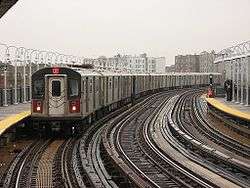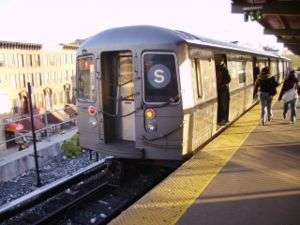BU cars (New York City Subway car)
BU cars is the generic term for BRT elevated gate cars used on predecessor lines of the New York City Subway system.
Background
These cars consisted of a variety of equipment used on the BRT and later BMT. Some cars were inherited from steam railroads that became part of the BRT system while others were built new for the BRT as late as 1907. In 1913, the BRT introduced an advanced steel car design for subway service (the AB Standard) and no more BU cars were produced.
The term BU was derived from the Brooklyn Union Elevated Railroad (BUERR) Company, one of the last operating companies of Brooklyn elevated lines before the BRT formed the New York Consolidated Railroad in 1912 to absorb the BUERR and other properties.
Historians disagree as to whether the term "BU" was commonly used before the BMT was purchased by the City of New York in 1940, or whether it was mainly an introduced term to describe the wooden elevated cars of the former private company.
Disambiguation
The primary distinguishing feature of BU cars is that they were elevated cars built mostly or substantially of wood, with or without steel frames, where passenger access to the cars was provided by open platforms at both ends of each car. A trainman between each pair of cars manually opened and closed folding gates to admit or bar passengers from entering or leaving.
All gate cars used in BRT elevated service can be described as BUs. This excludes several classes of elevated equipment:
- Steam coaches of companies preceding the BUERR that were never converted to, and used in, regular BUERR or BRT elevated service;
- Steam excursion coaches of the former Sea Beach Railway that were acquired by the BRT ("3200 class") but not used in elevated service and numbered as part of the streetcar department;
- Former BU cars (the C-types and Q-types) that were converted into closed cars and the gates replaced by automatically operated subway-style sliding doors.
BUs in the New York Transit Museum fleet
| Current Numbers | 1407 | 1273 | 1404 |
|---|---|---|---|
| 1970 numbers | 1622A | 1622B | 1622C |
| 1957 numbers | 1622A | 1622B | 1603C |
| 1937 numbers | 1407 | 1273 | 1404 |
| Body builder | Jewett | Laconia | Jewett |
| Frame builder | Pressed Steel | Pressed Steel | Pressed Steel |
| Build Date | 1907 | 1903 | 1907 |
Three BU cars that were converted to closed Q-type cars in 1938–39 for BMT service to the 1939 New York World's Fair were converted back to BU gate cars in the Coney Island Rapid Transit Car Overhaul Shop for the transit museum. All of the cars are operational.
These cars are the oldest operational members of the New York Transit Museum fleet. They are made of wood with steel frames and date from 1903–07. Those built in 1907 were the last BU cars ever built. They are occasionally used on excursions. However, when the excursion goes through underground subway tunnels, they must be towed by steel cars. For safety reasons, passengers may not ride in these cars in subway tunnels; non-employees must ride in the accompanying steel cars during the tunnel portions of the trip.
The three museum BUs are currently numbered and coupled as 1407-1273-1404. They were rebuilt from Q-type unit 1622A-B-C in the late 1970s. As part of the June 22, 1965 "Transit Day" commemoration at the World's Fair, Q-type 1622A-B-C were rehabilitated and repainted in the original colors used for the 1939-40 World's Fair, blue and orange,[1] which are also the colors of the New York City flag. Many other still-extant cars are located around the country, particularly at Shore Line Trolley Museum.
References
- ↑ "The Road to the Transit Museum, by Irvin & Paul Matus; Page 7 (TheThirdRail,net)". Thethirdrail.net. Archived from the original on 2012-02-05. Retrieved 2012-05-17.


